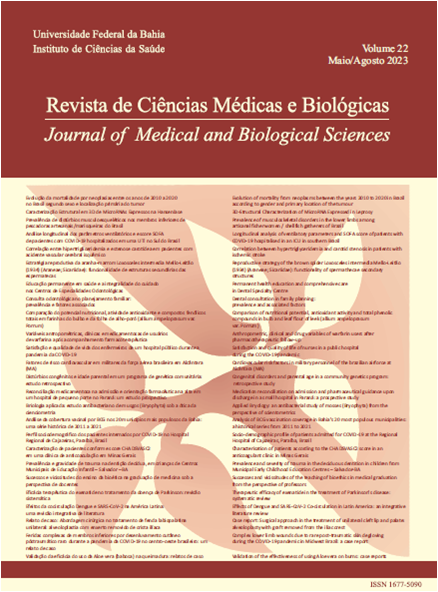COMPARISON OF THE NUTRITIONAL POTENTIAL, ANTIOXIDANT ACTIVITY AND TOTAL PHENOLIC COMPOUNDS IN BULB AND LEAF FLOURS OF LEEK (ALLIUM AMPELOPRASUM VAR. PORRUM)
DOI:
https://doi.org/10.9771/cmbio.v22i2.51497Keywords:
antioxidants, phenolic compounds, Allium porrum, whole utilization off FoodsAbstract
Introduction: The leek (Allium ampeloprasum var. Porrum) has been consumed for thousands of years, being generally consumed for the use of the bulb. The vegetables of the genus Allium, such as leeks, stand out for the presence of a variety of phytochemicals, which are also present in parts not used as leaves.Objective: To identify and compare the nutritional composition, antioxidant activity and total phenolic compounds in flours of the bulb and leaf of leek. Methodology: The centesimal composition was performed according to Adolf Lutz Institute method, the antioxidant activity was performed using the methods with DPPH, ABTS+ and FRAP radicals and the quantification of total phenolic compounds was performed with Folinciocalteu reagent. Results: The leaf and bulb flours presented similar centesimal composition with emphasis on fiber, the leaf flour stood out for its mineral and protein content, the antioxidant activity and amount of phenolic compounds presented higher in the leek leaves. Conclusion: The leek leaf stands out for its reor of mineris, its high content of protein, fiber, high antioxidant activity and content of phenolic compounds, The flours obtained from the leek leaf and bulb present favorable characteristics for use in dietary preparations, as a way to increase the nutritional qualities and bioactive compounds, being the integral utilization of the leek an alternative of nutritional and functional potential viable in the contribution of reducing food waste.
Downloads
Downloads
Published
How to Cite
Issue
Section
License
Copyright (c) 2023 Journal of Medical and Biological Sciences

This work is licensed under a Creative Commons Attribution 4.0 International License.
The Journal of Medical and Biological Sciences reserves all copyrights of published works, including translations, allowing, however, their subsequent reproduction as transcription, with proper citation of source, through the Creative Commons license. The periodical has free and free access.


